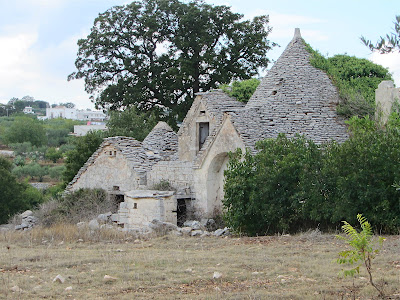Tired of the highway, we exited and stumbled around on the local roads for the rest of the day, defying the instructions of our Garmin GPS. We found Ostuni, on top of a hill in a rain storm. The setting over looks the Adriatic. Most of the building are painted white, a Greek influence, giving "La Città Bianca" a dramatic look from inside and afar. After checking out the cathedral and the twisting, narrow streets, we sheltered under a restaurant umbrella for salad during another shower. A Belgian couple, also lunching, spoke excellent English, and we discussed American and European politics—they’re not Romney fans.
Back on the road, two lanes and some only one, we saw more of the olive groves and vineyards, grape harvesting, ruins and new buildings, and, on the road to Alberobello, we first saw trulli. The trulli are round, conical roofed, stone, one-roomed dwellings that may be grouped for multi-room houses. There’s an inside stone dome ceiling and an outside stone shingled roof, giving them a unique appearance. We thought of tepees and igloos as other simple, round housing. In Alberobello, there are two hillsides covered with hundreds of trulli, mostly white-washed and grouped together for more interior space.
We rounded out the day back at the hotel with a nap and then a late dinner in town.

Lecce has many churches, cathedrals, basilicas, chapels surrounding Roman ruins in the old town. This is Sant'Irene.

And this is the Cathedral.

Ostuni, the White City, sits atop a hill in sight of the Adriatic.

Ostuni, narrow streets, heavily flowered.

Truly unique dwellings are the trulli. Those in the countryside are rustic. [duh]

While the city trulli are all white washed.

No comments:
Post a Comment